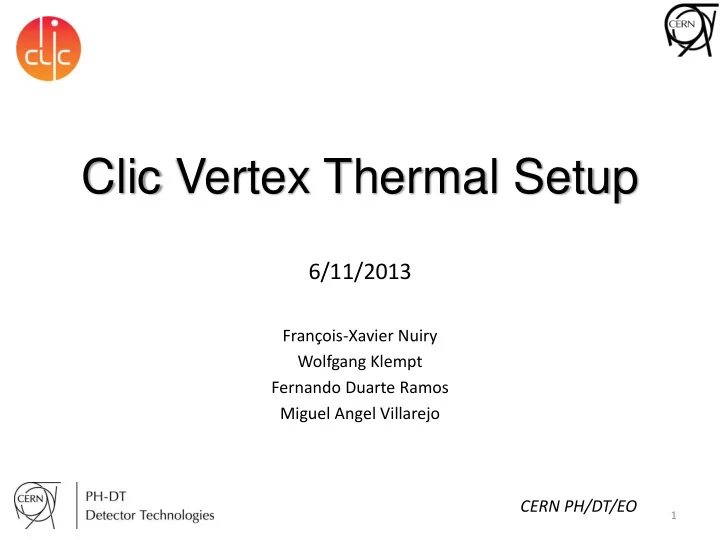

Clic Vertex Thermal Setup 6/11/2013 François-Xavier Nuiry Wolfgang Klempt Fernando Duarte Ramos Miguel Angel Villarejo CERN PH/DT/EO 1
Set up status Labview software DAQ system 2
Labview program status -First acquisition program realised thanks to SAMIR A. Many thanks to him. -The program is now working for 3 (4) anemometers and one PT1000 temperature sensor. The labview test interface: 3
Labview program status -The program is now working for 3 (4) anemometers and one PT1000 temperature sensor. The labview construction interface: 4
DAQ status DAQ system (implemented): 1 NI Compact DAQ 9188 (8 slots) 1 NI 9208, 24-bit current input module 2 NI 9219, Universal module, 4 channels, 24 bit, +/-24V 5
DAQ status Sensors: • 4 Anemometers Schmidt SS20.400 Preliminary tests: 3 seems to give a very similar current output 1 sensor clearly gives a lower current output (by ~10%) The French seller has been contacted The German manufacturer will test the problematic sensor Contact : Mr. Regis Houllier Email: regis.houllier@airlitec.com SCHMIDT Technology GmbH Web: www.airlitec.com Attn: Kenan Kanmaz Feldbergstrasse 1 78112 St. Georgen Allemagne Tel : +49 (0) 77 24 / 89 90 Fax : +49 (0) 77 24 / 89 91 01 6
DAQ status Sensors: • Temperature sensors Preliminary tests: PT 1000 given by Samir is working quite well Problems: 1- We don’t know which type of PT1000 it is (Pt3850…?)? 2- Such PT 1000 are equipped with rather thick leads, 3- Heat dissipated during measurments (P=R*I 2 = 1000 Ω *(500.10 -6 ) 2 A 2 = 0.00025W ), to be compared with the 0.050W/cm 2 Ratio: 0.050/0.00025 = 200 Should be OK. NTC thermistors Semitec 103JT Comments: 1- High resistance (>18k Ω ) not readable by the NI 9219 card (max =10.5k Ω ). 2- Could be read by the NI AI 0-10V (type 9205) via the installation of a conditioning system 3- May be not very useful as our temperature range is only +10°C / +40°C. Possible upgrades (See next slide) 7
DAQ possible upgrades Sensors: • Temperature sensors. Possible upgrades: Buy our own PT1000 sensors and mount it with very thin leads (AWG 36 for instance) Ex: Pt 3850 ppm/K (Can be tested in water) 0.8mm 1.2mm 1.6mm For the moment 8 PT1000 can be mounted. For more sensors the following NI card can be bought: NI 9205 (16 voltage channels) (779 dollars) NI 9208 (16 current channels)(633 dollars) Should be selected has better accuracy with long leads. Here the conditioning system is not included and has to be added (TK3 system, 150CHF/ channel) 8
DAQ possible upgrades Active systems (not yet implemented, need new NI module): -Fan (0-10V input) -Heaters (2 times 50mW/cm2) Investigations are currently done in collaboration with Antoine Kerhli (PH/DT). May be we could ask for more support also from Samir? NI9269 4-Channel, ±10 V, 16-Bit, Simultaneous, Channel to-Channel Isolated Analog Voltage Output Module 9
DAQ possible upgrades Laser vibration sensors Micro-Epsilon seller visit on Tuesday 5/11 Show of 2 sensor types: Capacitive and laser. Precise but needs to be close to the Can accept up to 40mm distance stave surface between the sensor and the stave (No flow perturbation) Please find more details on the sensor datasheet. Price ~5500CHF 10
Stave support status 1 st prototypes printed in 3D (ABS Plus) - Low quality - Can be used as preliminary tests 2 nd prototypes printed in epoxy reinforced resin: Mounted in the set up. 11
First aeraulic tests proposal OBJECTIVE: Understand the wind speed for different scenarios. Get a idea of the best configuration to test staves (sensor position, etc.) Wind speed measurements for: Same conditions, with different sensors (started with W. and FX.): compare sensors. Same conditions, with two/three different sensor locations: study wind speed distribution. Same conditions, with two/three different sensor positions (height). Study the wind perturbation by objects (stave, leads, sensors…). … See parameters on Fernando Word sheet 12
Short – Mid term strategy Discussions VALIDATE the DAQ system (4 anemometers, temperature sensors) Implementation of the command of active components (heaters, fan)? First tests: -Calibration of the sensors (Started) -Elaboration of test protocols (stave orientation, space around the stave, wind speed, presence of heaters, outputs…) ONGOING Laser sensors order Waiting for a quote. 13
Recommend
More recommend